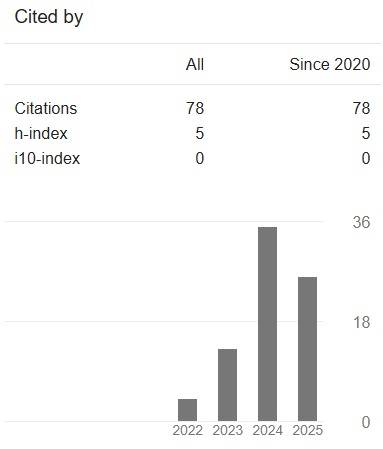The Analysis of Fluid Flow on Different Kapok Filter Orientations using Computer Fluid Dynamics
DOI:
https://doi.org/10.24191/jaeds.v3i2.63Keywords:
kapok, filter, pressure drop, flow condition, water surface and waveAbstract
Kapok fibres, known for their hydrophobic (water-repellent) and oleophilic (oil-attracting) properties, could be used as a filtration medium. In the context of oily water filtration, kapok fibres might naturally attract and capture oil droplets from the water while allowing water to pass through. However, the effectiveness of the filtering process depends on the filter orientation, which affects the fluid flow, either turbulent or laminar. Thus, the study investigated the effect of filter orientation housing during installation on the fluid flow around the kapok filter. The study used Computational fluid dynamic analysis, CFD, for two different kapok filter orientations, parallel and perpendicular to the water flow. It found that the kapok filter oriented perpendicular generates turbulence on the surrounding flow and hydraulic jump as compared to parallel orientation. A higher risk of clogging could happen due to debris accumulation and reduced filtering process.
Downloads
References
Q. Teng, D. Zhang, and C. Yang, "A review of the application of different treatment processes for oily sludge," Environmental Science and Pollution Research, vol. 28, pp. 121-132, 2021.
D. F. Mohshim, R. Nasir, H. A. Mannan, A. Abdulrahman, and H. Mukhtar, "Challenges of industries in dealing with oily wastewater release and treatments," in Advanced technologies in wastewater treatment: Elsevier, 2023, pp. 49-70.
U. H. Yim, M. Kim, S. Y. Ha, S. Kim, and W. J. Shim, "Oil spill environmental forensics: The Hebei Spirit oil spill case," ed: ACS Publications, 2012.
M. Preisner, E. Neverova-Dziopak, and Z. Kowalewski, "An analytical review of different approaches to wastewater discharge standards with particular emphasis on nutrients," Environmental Management, vol. 66, pp. 694-708, 2020.
L. A. Mokif, H. K. Jasim, and N. A. Abdulhusain, "Petroleum and oily wastewater treatment methods: a mini review," Materials Today: Proceedings, vol. 49, pp. 2671-2674, 2022.
M. Han, J. Zhang, W. Chu, J. Chen, and G. Zhou, "Research progress and prospects of marine oily wastewater treatment: A review," water, vol. 11, no. 12, p. 2517, 2019.
M. J. Kratochvil, U. Manna, and D. M. Lynn, "Superhydrophobic polymer multilayers for the filtration‐and absorption‐based separation of oil/water mixtures," Journal of Polymer Science Part A: Polymer Chemistry, vol. 55, no. 18, pp. 3127-3136, 2017.
Y. Zhu et al., "Zwitterionic nanohydrogel grafted PVDF membranes with comprehensive antifouling property and superior cycle stability for oil‐in‐water emulsion separation," Advanced Functional Materials, vol. 28, no. 40, p. 1804121, 2018.
Y. Liu et al., "Asymmetric aerogel membranes with ultrafast water permeation for the separation of oil-in-water emulsion," ACS applied materials & interfaces, vol. 10, no. 31, pp. 26546-26554, 2018.
M. Rana, J. T. Chen, S. Yang, and P. C. Ma, "Biomimetic superoleophobicity of cotton fabrics for efficient oil–water separation," Advanced Materials Interfaces, vol. 3, no. 16, p. 1600128, 2016.
M. Padaki et al., "Membrane technology enhancement in oil–water separation. A review," Desalination, vol. 357, pp. 197-207, 2015.
J. Gu, W. Jiang, F. Wang, M. Chen, J. Mao, and T. Xie, "Facile removal of oils from water surfaces through highly hydrophobic and magnetic polymer nanocomposites," Applied Surface Science, vol. 301, pp. 492-499, 2014.
T. Dong, G. Xu, and F. Wang, "Adsorption and adhesiveness of kapok fiber to different oils," Journal of Hazardous Materials, vol. 296, pp. 101-111, 2015.
C. J. Singh, S. Mukhopadhyay, and R. Rengasamy, "A sustainable approach to oil spill cleanup by kapok and waste cotton needle punched nonwoven blends," Industrial Crops and Products, vol. 191, p. 115939, 2023.
J. Wang, Y. Zheng, and A. Wang, "Effect of kapok fiber treated with various solvents on oil absorbency," Industrial crops and products, vol. 40, pp. 178-184, 2012.
X. Huang and T.-T. Lim, "Performance and mechanism of a hydrophobic–oleophilic kapok filter for oil/water separation," Desalination, vol. 190, no. 1-3, pp. 295-307, 2006.
S. Renuka, R. Rengasamy, and D. Das, "Studies on needle-punched natural and polypropylene fiber nonwovens as oil sorbents," Journal of Industrial Textiles, vol. 46, no. 4, pp. 1121-1143, 2016.
M. Abdullah, A. U. Rahmah, and Z. Man, "Physicochemical and sorption characteristics of Malaysian Ceiba pentandra (L.) Gaertn. as a natural oil sorbent," Journal of hazardous materials, vol. 177, no. 1-3, pp. 683-691, 2010.
Q. Song, J. Kang, M. Tang, and Y. Liang, "Separation of Water in Diesel Using Filter Media Containing Kapok Fibers," Materials, vol. 13, no. 11, p. 2667, 2020.
T. Dong, S. Cao, and G. Xu, "Highly efficient and recyclable depth filtrating system using structured kapok filters for oil removal and recovery from wastewater," Journal of hazardous Materials, vol. 321, pp. 859-867, 2017.
C.-G. Liang, H. Lui, B. Hao, and P-C. Ma, "Optimisation on the performance of fibrous filter through computational fluid dynamic simulation coupled with response surface methodology," Chemical Engineering Science, vol. 280, p. 119070, 2023.
Downloads
Published
How to Cite
Issue
Section
License
Copyright (c) 2023 Azizul Hakim Samsudin, Ab Aziz Mohd Yusof, Norhafini Hambali, Mohammad Abdullah, Nur Darina Ismail

This work is licensed under a Creative Commons Attribution 4.0 International License.









